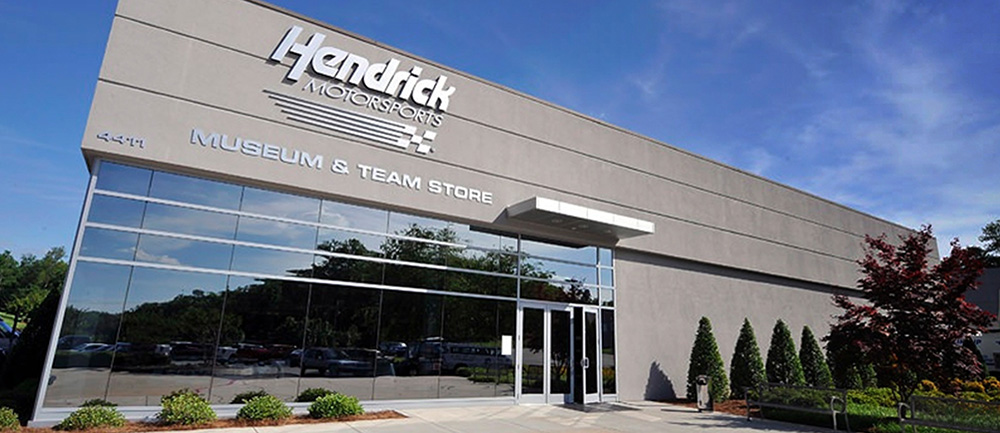CONCORD N.C. - This weekend, race engineers will be put to the test as the NASCAR Cup Series and the NASCAR Xfinity Series put rubber to the road in Mexico City.
The Autódromo Hermanos Rodríguez racecourse has many unique features about it, one of which is its disposition above sea level. With an elevation of over 7,000 feet, the circuit lives in a thinner air pressure that affects the entire car. Among the differences will be changes in producing power, managing tire wear, fuel consumption and overheating.
But it all starts with the engine. And it's up to the shop to provide a power source that's reliable at elevation. That is why Scott Maxim, powertrain director at Hendrick Motorsports, is pushing his team to make the best eight engines (including customer) they possibly can ahead of the Cup Series inaugural race in Mexico.
RELATED: Check out the Hendrick Motorsport paint schemes this week
With no current track on the calendar matching the unique properties that Mexico City presents, the engine team had a lot going against them ahead of this inaugural race. On top of the uniqueness, travel schedules required all cars to be completed prior to last weekend's race at Michigan International Speedway. Pushing up an already tight deadline.
"We don't have a lot of reference points at a higher elevation for us to use as a guide," Maxim said. "Sonoma (Calif.) is near sea level. Watkins Glen, which we race at in New York, is about 460 feet above sea level. None of the circuits are at a high elevation, so this will be all new to us."
In order to stay competitive during the race, the team has to rely on their general road course knowledge and data from other racing series to help build the engines to withstand thin air pressure while also lasting the duration of the race.
"We'll maintain the same build specification based on what we understand from the limited amount of driver simulation that we've been able to determine," Maxim said when discussing how to build an engine for a new circuit. "There's a broad RPM range that the engine will run. From as low as 3,500 RPM to our maximum allowed of 9,000 RPM, that's a broad RPM range of nearly 6,000 RPM. Elevation does not play a factor into that. It is all about the RPM range.
"We look at the engines operating range of RPM and we look at the racetrack for where the power relative to corner exit down the straightaway is most optimized to be able to provide our drivers with passing opportunities. We want to provide them with the tools they need to do their job to their highest capability. We'll look at that in terms of corner exit RPM down the straightaway and try and optimize the power band for the best competitive performance," Maxim added.
RELATED: First to the party: Hendrick Motorsports' history of success in inaugural races
There is a unique challenge when racing at such high altitudes. The engine has to accommodate more than just how fast the car is going. It has to be able to take in fuel to move the pistons, disperse power throughout the car, and endure a three-hour race at a track which requires high speeds and heavy braking.
"The circuit is approximately 7,400 feet above sea level, so that in comparison to our typical road course that we race on is about a 22% reduction in air density and with that reduction, we have a near equal amount of power loss. The fuel consumption will be near equal to what that is," Maxim said.
"The air is 22% less dense and therefore a naturally aspirated engine like the one we run in the NASCAR Cup Series and the Xfinity Series will produce a corresponding percentage of less power as a result of the air density decrease. We will also use a near equal amount of reduced fuel, so we'll see a significant amount of fuel reduction. We have to tune accordingly for the reduced air density, and we've had to make adjustments in our calibration to better match the lower air density of Mexico City," Maxim followed up.
"In addition to all of that, the air density decrease also has an impact on our cooling systems that are reliant upon the airflow from the racecar, so engine cooling, water and oil cooling, transaxle and driver cooling are impacted by the air density. We've got to make adjustments there in our cooling systems to allow for better airflow to try and overcome that reduced efficiency," Maxim concluded.

Thankfully for the teams, NASCAR is allowing two practice sessions this weekend to compensate for the unknowns. Maxim plans on taking full advantage of both.
"We welcome the fact that we get two practices. The first is 50 minutes long and the second being 20, will allow us to do some additional confirmation and fine tuning," Maxim said.
Despite the obstacles of racing outside the U.S. at a new circuit that is unlike anything the Cup Series has raced on previously; Maxim and his team are happy that NASCAR is getting its name out to newer audiences.
"I think it's great for NASCAR and our sport and our sponsors to showcase our race team and all the work and dedication that go into our cars and engines," Maxim said. "I think it is great for us, and I welcome that. Showcasing our teams, drivers and cars to more people is a positive."
You can watch all four Hendrick Motorports drivers put these engines to the test this weekend. Catch the main event at 3 p.m. ET Sunday, June 15 on Prime Video.




















